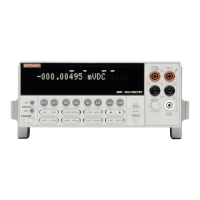IEEE-488 Reference
4-29
4.9 Programming syntax
The following programming syntax information covers both common commands and SCPI
commands. For information not covered here, refer to the documentation for the IEEE-488.2
standard and SCPI.
Command words
One or more command words make up the program message that is sent to the computer to per-
form one or more operations.
1.
Commands and command parameters:
Both common commands and SCPI commands
may or may not use a parameter. Examples:
*SAV 0 Parameter (0) required.
*RST No parameter used with this command.
:INITiate:CONTinuous <b> Parameter (<b>) required.
:SYSTem:PRESet No parameter used with this command.
Note that there must be a space between the command word and the parameter.
Brackets [ ]:
Throughout this manual, you will find command words that are enclosed in
brackets ([]). These brackets are simply used to denote an optional command word that does
not need to be included in the program message. For example:
:INITiate[:IMMediate]
The brackets indicate that :IMMediate is implied (optional) and does not have to be used.
Thus, the above command can be sent in one of two ways:
:INITiate or :INITiate:IMMediate
Notice that the optional command is used without the brackets.
Do not include the brack-
ets when using an optional command word.
Parameter types:
Some of the more common parameter types used in this manual are ex-
plained as follows:
<b> Boolean: Used to enable or disable an instrument operation. 0 or OFF dis-
ables the operation, and 1 or ON enables the operation. Example:
:CURRent:AC:RANGe:AUTO ON Enable auto-ranging.
AC|DC Explicit: This is an example of two explicit parameters to choose from; AC
or DC. Example:
:CURRent:AC:COUPling AC Select AC coupling
<name> Name parameter: Select a parameter name from a listed group. Example:
<name> = NEVer
= NEXt
= ALWays
= PRETrigger
:TRACe:FEED:CONTrol PRETrigger

